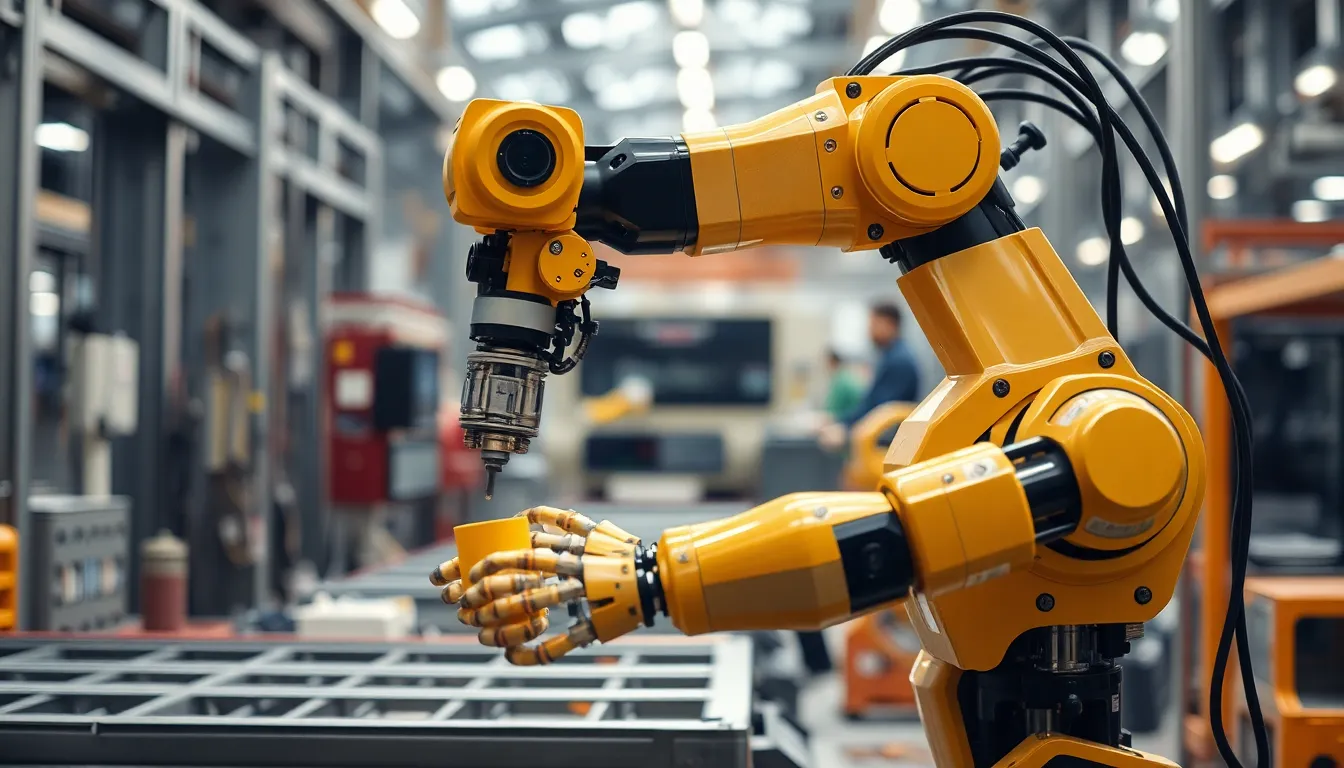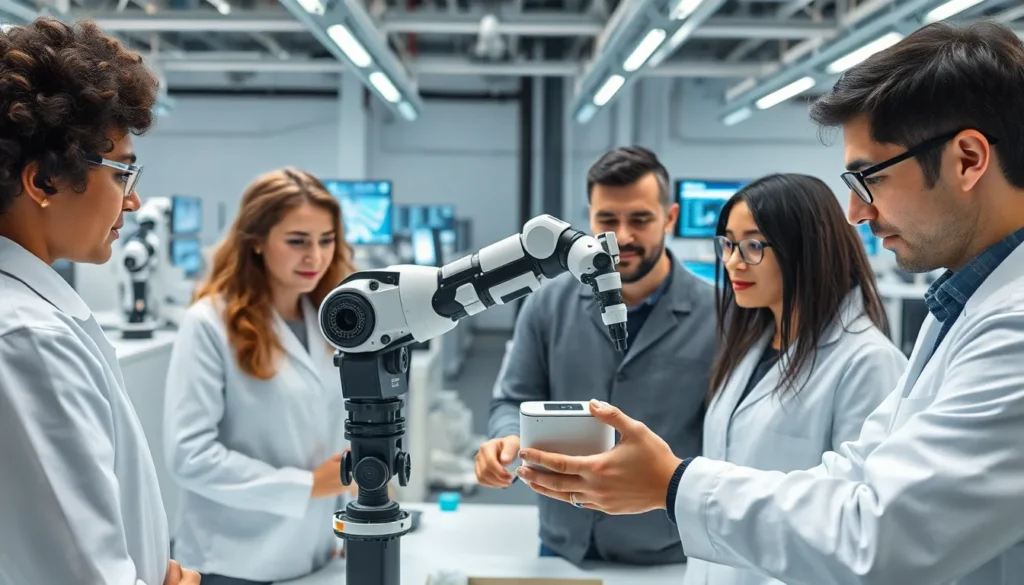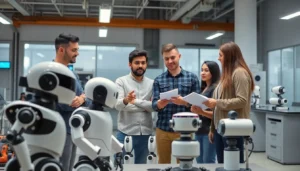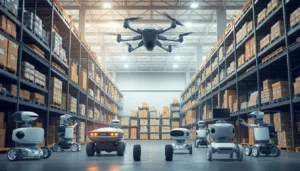Artificial Intelligence is revolutionizing the field of robotics, pushing the boundaries of what machines can achieve. As technology advances, robots are no longer just tools; they’re becoming intelligent partners capable of learning, adapting, and performing complex tasks. This shift is not just about automation; it’s about creating systems that can think and respond in real time.
In this dynamic landscape, AI plays a crucial role in enhancing robotic capabilities, from perception and decision-making to interaction with humans and environments. As industries embrace these innovations, the potential for increased efficiency and productivity grows exponentially. Understanding the intersection of AI and robotics is essential for anyone looking to grasp the future of technology.
Table of Contents
ToggleOverview of AI in Robotics Development
AI significantly transforms robotics by enhancing capabilities and expanding applications. AI algorithms enable robots to process data efficiently, learn from experiences, and make independent decisions. These advancements lead to more intelligent robots that perform tasks in unpredictable environments.
Robotic perception systems utilize AI for improved sensory interpretation. Vision systems, equipped with computer vision algorithms, allow robots to recognize objects, navigate spaces, and interact with humans more intuitively. This capability fosters greater collaboration between robots and individuals in diverse settings.
Decision-making algorithms play a vital role in robotics development. They facilitate real-time analysis of data inputs, enabling robots to adapt to new situations quickly. For instance, robotic arms equipped with AI can adjust their movements based on feedback, ensuring precision in tasks such as assembly and surgery.
Human-robot interaction also benefits from AI advancements. Natural language processing allows robots to understand and respond to verbal commands, enhancing communication with users. This technology encourages widespread adoption in healthcare, customer service, and education sectors.
AI’s integration into robotics leads to increased efficiency and productivity across industries. Industries leverage AI-powered robots for repetitive tasks, optimizing operations and reducing human error. As more businesses adopt these technologies, the growth potential of AI in robotics remains substantial.
Key Technologies Driving AI in Robotics

AI in robotics relies on various key technologies that enhance functionality and performance. These technologies integrate to create intelligent systems capable of advanced operations across industries.
Machine Learning Techniques
Machine learning techniques empower robots to analyze vast datasets and derive insights. Supervised learning algorithms enhance robots’ ability to recognize patterns in tasks such as object classification. Unsupervised learning enables autonomous adaptation to new conditions without explicit instructions. Reinforcement learning provides robots with feedback to optimize decision-making processes during multi-step tasks. These techniques contribute to the creation of learning agents that improve through experience, resulting in increased adaptability in manufacturing, logistics, and healthcare applications.
Computer Vision Innovations
Computer vision innovations significantly enhance robots’ ability to perceive and understand their surroundings. Advanced optical sensors and camera systems facilitate real-time image processing, enabling object detection and tracking. Algorithms like convolutional neural networks (CNNs) help robots analyze visual data for tasks such as obstacle avoidance and environment mapping. Enhanced depth perception technologies, including LiDAR, provide three-dimensional mapping capabilities, fostering better navigation. These innovations lead to robots that can interact seamlessly with complex environments, improving their efficiency in sectors such as agriculture, security, and service delivery.
Applications of AI in Robotics
AI significantly enhances the capabilities of robots across various sectors, allowing for increased efficiency and effectiveness in performing tasks. Notable applications include industrial automation, healthcare robotics, and service robots.
Industrial Automation
AI-driven robots are revolutionizing industrial automation. These robots optimize production lines by using machine learning algorithms to adapt to changing conditions. Predictive maintenance strategies enable real-time machinery monitoring, minimizing downtime and maximizing productivity. AI-powered robotic arms perform precision tasks in assembly, welding, and packaging, enhancing speed and accuracy. For example, automotive manufacturers utilize these systems to assemble vehicles quickly and efficiently.
Healthcare Robotics
AI enhances healthcare robotics by improving patient care and surgical procedures. Surgical robots equipped with AI algorithms perform minimally invasive operations, providing higher precision and reducing recovery time. AI systems analyze patient data to assist in diagnostics, enabling personalized treatment plans. Additionally, robotic exoskeletons support rehabilitation efforts, allowing patients to regain mobility effectively. Hospitals utilize AI-driven robots for tasks like medication delivery, ensuring accuracy and safety.
Service Robots
AI applications in service robots streamline customer interactions and enhance user experiences. These robots handle tasks such as cleaning, food delivery, and guidance in public spaces. Natural language processing capabilities allow for seamless communication between humans and robots, improving customer service in retail and hospitality sectors. For instance, AI-powered chatbots assist with inquiries, while delivery robots navigate complex environments to reach customers efficiently.
Challenges in AI-Powered Robotics
AI-powered robotics faces several challenges that affect their development and deployment across various sectors. These challenges include ethical considerations and technical limitations.
Ethical Considerations
AI in robotics raises significant ethical concerns. These concerns include accountability in decision-making, privacy issues, and the potential for job displacement. Robots equipped with AI can make autonomous decisions, leading to questions about responsibility, especially in critical areas like healthcare and law enforcement. Similarly, the use of data for training AI systems poses risks to user privacy, requiring strict policies to safeguard sensitive information. Additionally, increased automation raises concerns about job loss in numerous industries, prompting discussions on the implications for the workforce and the necessity of upskilling.
Technical Limitations
Technical limitations hinder the full potential of AI in robotics. These limitations include issues with data quality, processing power, and sensor accuracy. Inconsistent or insufficient data can impair AI algorithm performance, affecting robots’ learning capabilities. Moreover, the hardware necessary to support advanced AI functionalities often requires high processing power, which may not be feasible for all applications. Lastly, sensor technologies may struggle to provide precise real-time data under varying conditions, limiting robots’ effectiveness in dynamic environments. Addressing these technical hurdles is crucial for advancing AI-powered robotics and expanding their application scope.
Future Trends in AI and Robotics
Emerging trends in AI and robotics signify profound advancements that shape various sectors. The integration of AI into robotics results in smart robots exhibiting improved autonomy, adaptability, and interaction capabilities. As technologies progress, specific trends are poised to dominate.
- Increased Autonomy
AI advancements enable robots to operate independently in complex settings. Enhanced algorithms empower robots to make rapid decisions and perform multi-step tasks without human intervention. Applications span agriculture, where autonomous drones monitor crops, and logistics, where robots manage inventory.
- Collaborative Robotics
Collaborative robots, or cobots, interact safely and efficiently with humans. These robots are designed with AI systems that allow for real-time adaptation to human actions. Industries leveraging cobots see improved productivity and worker safety, especially in manufacturing and healthcare.
- Human-Robot Interaction (HRI) Improvement
Advances in natural language processing lead to more intuitive HRI. Robots equipped with conversational AI understand and respond to human language effectively. This enhancement fosters easier integration of robots in customer service roles and educational environments.
- Robust Data Utilization
The utilization of big data enhances AI capabilities in robotics. Robots that analyze large datasets refine their algorithms and improve performance over time. In sectors like healthcare, data-driven insights lead to better diagnostic tools and predictive maintenance solutions.
- Edge Computing Integration
Edge computing allows for real-time data processing on-site rather than relying solely on cloud services. This trend enhances robots’ operational efficiency by reducing latency in decision-making. Industries such as transportation benefit from faster data-driven responses.
- Ethical AI Development
As AI expands in robotics, ethical considerations grow more prominent. Developers focus on creating transparent algorithms and ensuring accountability in AI decision-making. Establishing ethical standards is crucial for public trust, especially in sensitive areas like healthcare and law enforcement.
- Sustainability Initiatives
Robotics development increasingly aligns with sustainability goals. AI-driven robots optimize resource use and reduce waste in manufacturing and logistics. This trend supports industries’ efforts to lower their environmental impact while improving efficiency.
- Enhanced Security Measures
As AI and robotics become more integrated, cybersecurity concerns also rise. Developers prioritize security features in robotic systems to protect against potential threats. This focus ensures safe operation in environments like finance and healthcare where sensitive data is present.
These trends highlight a transformative direction for AI and robotics, promoting efficiency and innovation across sectors. Understanding these shifts is essential for companies looking to stay competitive in a rapidly evolving technological landscape.
AI’s integration into robotics is reshaping industries and redefining the capabilities of machines. As robots become more intelligent and adaptable, they’re not just automating tasks but enhancing human collaboration and decision-making processes. The advancements in machine learning and computer vision are pivotal in this transformation, allowing robots to operate effectively in unpredictable environments.
While challenges like ethical concerns and technical limitations remain, the potential for growth and innovation is immense. Future trends point toward greater autonomy and improved human-robot interaction, ensuring that AI-powered robotics will continue to evolve. Embracing these changes will be crucial for businesses looking to thrive in an increasingly competitive landscape.










